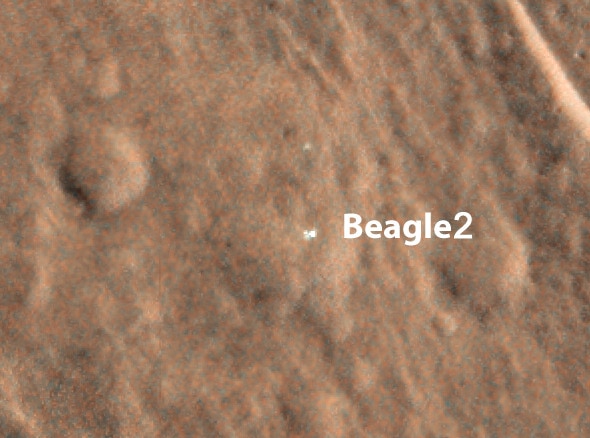Create a free profile to get unlimited access to exclusive videos, sweepstakes, and more!
Beagle 2, Lost on Mars a Decade Ago, Has Been Found

In late December 2003, the European Space Agency’s Mars Express spacecraft entered orbit around the red planet. Part of the mission was to send a lander, the Beagle 2, down to the surface to study the geology and other conditions at a site where water was known to have existed long ago.
Things didn’t go as planned. The lander went down but never sent a signal back home. Efforts to recover anything were for naught, and no one even knew if it landed successfully or if it had crashed onto Mars. The lander was declared lost in February 2004.
But now it’s been found! Using images from the HiRISE camera on the Mars Reconnaissance Orbiter, the Beagle 2 has definitely been spotted on the surface. Not only that, but it looks intact; that is, it didn’t crash into the surface. It appears to have landed safely … but it also looks like the solar panels needed to power it didn’t fully deploy.
That spelled doom for two reasons. It couldn’t get all the juice needed to operate, but also the panels, which were supposed to open like flower petals, needed to be fully deployed to uncover the antenna used to communicate back to Mars Express and therefore to Earth. With the antenna blocked, the mission was doomed.
In some sense this is, well, not good news, but welcome. The lander, sadly, is dead and has been for a decade; there’s nothing that can be done about that. But, it shows that the mission did touch down safely, and that’s a very big deal to the engineers who designed the mission and who want to know what went wrong. Follow-up images will hopefully show which panels opened and which didn’t, and that may lead to a better understanding of why they failed.
It’s taken so long to find it because the lander is just a couple of meters across, and it landed in a region more than 15,000 square kilometers in size. Here’s an image that has the Beagle 2 in it. See if you can find it. Have fun.
It’s awful that this part of the mission failed—and mind you, the Mars Express Orbiter itself has been running beautifully and taking images and data of Mars for 11 years now!—but this is not the last time the ESA will want to land on Mars. A failed mission is a learning opportunity, and finding Beagle 2 means the chances of the next landing being a success just went up.
I tip my hat to the Beagle 2 team and to the lander itself. May its travails lead to better fortunes down the line.


























